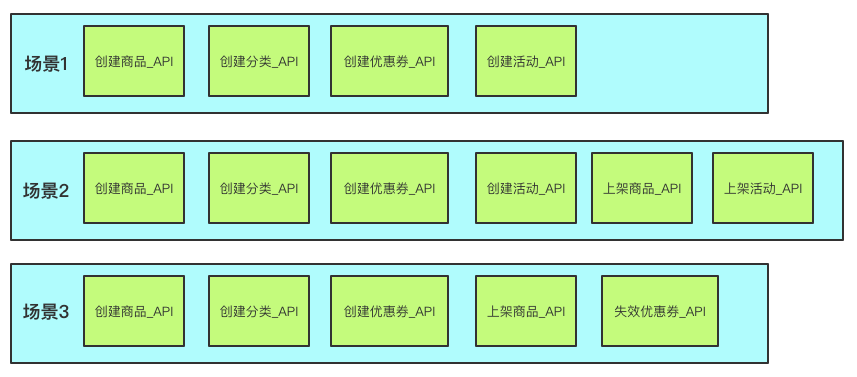本文以笔者当前使用的自动化测试项目为例,浅谈分层设计的思路,不涉及到具体的代码细节和某个框架的实现原理,重点关注在分层前后的使用对比,可能会以一些伪代码为例来说明举例。
接口测试三要素:
-
参数构造
-
发起请求,获取响应
-
校验结果
一、原始状态
当我们的用例没有进行分层设计的时候,只能算是一个“苗条式”的脚本。以一个后台创建商品活动的场景为例,大概流程是这样的(默认已经是登录状态下):
创建商品-创建分类-创建优惠券-创建活动
要进行接口测试的话,按照接口测试的三要素来进行,具体的效果如下:
# 1、参数构造
createCommodityParams = {
"input": {
"title": "活动商品",
"subtitle": "",
"brand": "",
"categoryLevel1Code": "12",
"categoryLevel2Code": "1312",
"categoryLevel3Code": "131211",
"detail": [
{
"uri": "ecommerce/1118d9.jpg",
"type": 0
}
],
"installInfo": {
"installType": 1,
"installFee": null
},
"pictureList": [
{
"uri": "ecommerce/222.jpg",
"main": true
}
],
"postageInfo": {
"postageType": 2,
"postageFee": 1,
"postageId": null
},
"sellerDefinedCode": "",
"publish": 1,
"skuList": [
{
"skuCode": "",
"externalSkuCode": "",
"price": 1,
"retailPrice": 6,
"stock": 100,
"weight": 0,
"suggestPrice": 0,
"skuAttrValueList": [
{
"attrCode": "COLOR",
"attrName": "颜色",
"attrValue": "绿色",
"attrValueId": "1001"
}
]
}
],
"jumpSwitch":false,
"recommendCommodityCodeList": [],
"recommendFittingCodeList": [],
"mallCode": "8h4xxx"
}
}
createCategoryParams = {......}
createCouponParams = {......}
createPublicityParams = {......}
publishCommodityParams = {......}
publishPublicityParams = {......}
createCommodityParams["input"]["title"] = "autoTest" + str(time.time())
createCommodityParams["input"]["mallCode"] = self.mallCode
createCommodityParams["input"]["skuList"][0]["price"] = random.randint(1,10)
createCategoryParams["input"]["categoryName"] = "autoTestCategory" + str(time.time())
createCouponParams。。。
createPublicityParams。。。
publishCommodityParams。。。
publishPublicityParams。。。
# 2、发起请求,获取响应
# 创建商品并获取商品code
createCommodityRes = api.getUrl("testApi.create.commodity").post.params(createCommodityParams)
commodityCode = createCommodityRes["commodityCode"]
# 创建分类并获取分类code
createCategoryRes = api.getUrl("testApi.create.category").post.params(createCategoryParams)
categoryCode = createCategoryRes["categoryCode"]
# 创建优惠券并获取优惠券code
createCouponRes = api.getUrl("testApi.create.coupon").post.params(createCouponParams)
couponCode = createCouponRes["couponCode"]
# 创建活动并关联商品,绑定优惠券,设置分类
createPublicityParams["input"]["commodityCode"] = commodityCode
createPublicityParams["input"]["categoryCode"] = categoryCode
createPublicityParams["input"]["couponCode"] = couponCode
createPublicityRes = api.getUrl("testApi.create.publicity").post.params(createPublicityParams)
# 结果校验(断言)
assert.equal(createPublicityRes["code"], 0)
assert.equal(createPublicityRes["publicityName"], createPublicityParams["publicityName"])
。。。
按照上面的写法,对于单个脚本的调式来说或许可以,但是一旦用例的数量和复杂程度积累起来后,其维护成本将是巨大的,或者可以说不具备可维护性。
弊端说明:
-
可读性差,所有的处理都放在一起,代码量大,不简洁直观
-
灵活性差,参数写死在脚本,适用用例范围小
-
复用性差,如果其他用例需要同样或类似的步骤,需要重新写一份
-
维护性差,如果接口有任何改动,那么所有涉及到此接口的脚本都需要一一修改
例如:随着用例场景的增加,就可能会出现下面这种情况

按照原始的模式,我们就需要些3个脚本文件分别来描述着3个场景,并且创建商品_API、创建分类_API、创建优惠券_API在场景1,2,3中均出现了;上架商品_API在场景2,3中均出现。由此我们完全可以预见到,当几百上千的用例场景出现后,这种形式是没有维护性可言的。
二、进化历程
因此我们依照着痛点,以最开始的原始状态为例,对用例进行分层改造,来看看进化后的状态。
1、API 定义层
我们编程的时候会将一些重复的代码进行封装使用,那么这里依然可以借用这种思想,我们将 API 的定义单独抽离,单独定义。
我们期望的效果是这样的:








 最低0.47元/天 解锁文章
最低0.47元/天 解锁文章















 279
279











 被折叠的 条评论
为什么被折叠?
被折叠的 条评论
为什么被折叠?








